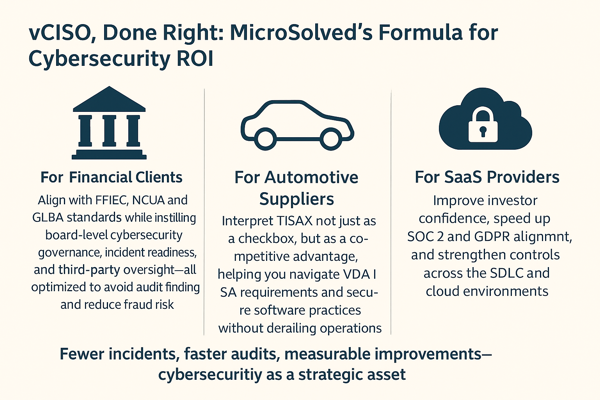Private Equity (PE) and Venture Capital (VC) firms face growing pressure to protect their investments from cyber threats. Whether it’s a high-profile data breach or tightening regulatory requirements like SOC2 compliance, the stakes are higher than ever. Yet, many portfolio companies—especially those in growth stages—often lack the internal expertise and resources to maintain a robust cybersecurity posture. This reality presents a significant risk, not only to the individual companies but also to the broader investment portfolio.
 Enter the vCISO (virtual Chief Information Security Officer) service from MicroSolved—a game-changer for PE and VC firms looking to secure their portfolios without the overhead of a full-time hire. With vCISO services, firms gain access to seasoned security professionals who provide expert leadership, tailor-made strategies, and proactive risk management to meet the unique needs of portfolio companies.
Enter the vCISO (virtual Chief Information Security Officer) service from MicroSolved—a game-changer for PE and VC firms looking to secure their portfolios without the overhead of a full-time hire. With vCISO services, firms gain access to seasoned security professionals who provide expert leadership, tailor-made strategies, and proactive risk management to meet the unique needs of portfolio companies.
The Value Proposition: Why MicroSolved’s vCISO Services Make Sense
MicroSolved’s vCISO services deliver high-value, flexible security solutions tailored to the needs of PE and VC firms. These services provide leadership and strategic oversight, ensuring that portfolio companies not only meet compliance obligations but also build a strong cybersecurity foundation that supports business growth. The best part? Firms can access top-tier security expertise without the need to hire a full-time, expensive CISO.
Here are the key benefits that PE and VC firms can expect from embracing vCISO services:
Key Benefits for PE and VC Firms
Tailored Security Assessments
One of the primary challenges that PE and VC firms face is the variability in cybersecurity maturity across their portfolio companies. Some companies may have developed a decent security posture, while others might be lagging dangerously behind. MicroSolved’s vCISO services provide tailored security assessments for each portfolio company. These assessments identify potential vulnerabilities early, significantly reducing the risk of costly breaches or fines.
Each company’s risk profile, industry, and specific challenges are considered, allowing for customized security strategies that target the most pressing vulnerabilities. This targeted approach not only enhances each company’s security posture but also safeguards the overall portfolio.
Enhanced Compliance
Regulatory compliance is a growing concern for both investors and portfolio companies, especially as frameworks like SOC2 become standard expectations. Non-compliance can lead to significant financial penalties and reputational damage, making it a critical area of focus.
MicroSolved’s vCISO services ensure that each company in the portfolio is aligned with necessary regulatory requirements. The vCISO team can seamlessly integrate cybersecurity practices into existing governance structures, streamlining audit processes, and ensuring smooth regulatory reviews. By centralizing compliance efforts across the portfolio, PE and VC firms can minimize legal risks while strengthening their companies’ market positions.
Operational Efficiency
Cybersecurity isn’t just about protecting data—it’s also about ensuring that business operations run smoothly. Downtime caused by breaches, ransomware, or other cyber incidents can halt operations and drain resources. A well-implemented cybersecurity program, driven by vCISO services, goes beyond protecting data to actively improve operational efficiency.
By aligning cybersecurity practices with overall business objectives, the vCISO service ensures that portfolio companies can scale without being derailed by cyber threats. Companies can avoid productivity losses due to security incidents and focus on their core missions—growing the business.
Risk Mitigation and Crisis Management
In today’s threat landscape, it’s not a question of if a cyberattack will happen, but when. PE and VC firms need a proactive approach to mitigate risks before they become full-blown crises. MicroSolved’s vCISO services offer 24/7 monitoring, proactive threat detection, and comprehensive incident response plans to minimize the impact of cyberattacks across portfolio companies.
Moreover, by establishing cybersecurity best practices across the portfolio, PE and VC firms ensure long-term resilience. This resilience is critical as threats continue to evolve, and a strong cybersecurity foundation will serve as a bulwark against future attacks.
Boost in Investor Confidence
Investors and Limited Partners (LPs) are increasingly focused on cybersecurity as a key indicator of portfolio stability. A robust cybersecurity strategy not only protects the companies in the portfolio but also enhances investor confidence. LPs are more likely to trust a PE or VC firm that demonstrates a commitment to securing their investments from cyber threats.
Additionally, companies with strong security postures are often more attractive for exits, IPOs, and acquisitions. A proven cybersecurity strategy not only reduces the risks associated with portfolio companies but can also increase firm valuations, positioning companies for successful exits and long-term success.
Conclusion
The cybersecurity landscape is growing more complex, and the risks facing PE and VC firms are greater than ever. To protect their investments, drive growth, and enhance portfolio performance, these firms must prioritize cybersecurity across their holdings. MicroSolved’s vCISO services provide a cost-effective, flexible, and expert solution for achieving these goals.
By offering tailored cybersecurity assessments, enhancing compliance, improving operational efficiency, mitigating risk, and boosting investor confidence, vCISO services deliver the strategic support needed to secure portfolio companies and position them for long-term success.
More Information
If you’re ready to protect and enhance the value of your portfolio, contact MicroSolved today to explore how our vCISO services can deliver tailored cybersecurity solutions. Secure your portfolio, ensure regulatory compliance, and position your investments for sustainable growth. You can reach us at +1.614.351.1237 or via email at info@microsolved.com. Get in touch now for a no-stress discussion about matching our capabilities and your needs.
* AI tools were used as a research assistant for this content.
 Unlike one-size-fits-all models, our vCISO engagements begin with immersive understanding: of your business model, sector-specific compliance demands (think NCUA/FFIEC for credit unions, TISAX for auto suppliers, GDPR/SOC2 for SaaS), and your organizational risk appetite. From there, we build a living security program that’s actionable, measurable, and defensible under scrutiny.
Unlike one-size-fits-all models, our vCISO engagements begin with immersive understanding: of your business model, sector-specific compliance demands (think NCUA/FFIEC for credit unions, TISAX for auto suppliers, GDPR/SOC2 for SaaS), and your organizational risk appetite. From there, we build a living security program that’s actionable, measurable, and defensible under scrutiny.
 Enter the vCISO (virtual Chief Information Security Officer) service from MicroSolved—a game-changer for PE and VC firms looking to secure their portfolios without the overhead of a full-time hire. With vCISO services, firms gain access to seasoned security professionals who provide expert leadership, tailor-made strategies, and proactive risk management to meet the unique needs of portfolio companies.
Enter the vCISO (virtual Chief Information Security Officer) service from MicroSolved—a game-changer for PE and VC firms looking to secure their portfolios without the overhead of a full-time hire. With vCISO services, firms gain access to seasoned security professionals who provide expert leadership, tailor-made strategies, and proactive risk management to meet the unique needs of portfolio companies.
